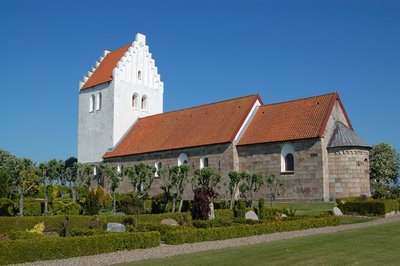
Tømmerby Church, Thy, 12 km west of Fjerritslev

An aristocratic profile
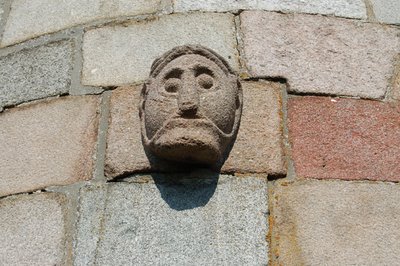
Maybe the portrait of a founder

Another founder or a stone mason?

Lion eating a human head

Hunter with dog

Deer chased by dog
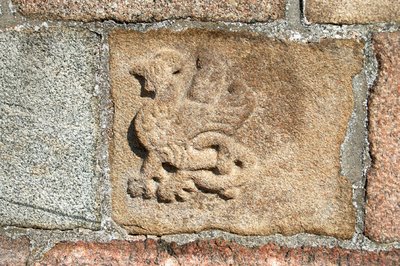
The basilisk
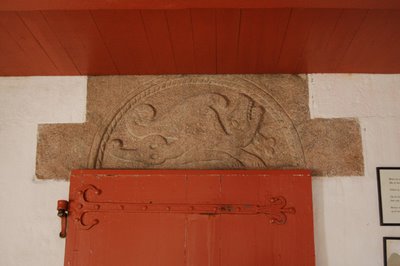
The dragon above the women's door
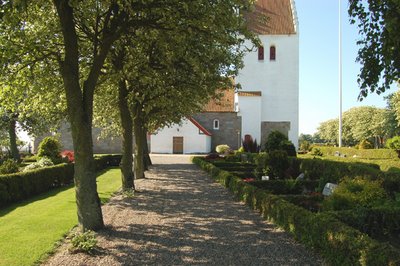
Tømmerby church yard on a peaceful sunny afternoon

Højstrup Viking burial area
Tømmerby Church is situated high above and with a wonderful view over Vejlerne, the vast sanctuary of the birds by Limfjorden.The large Romanesque church in Thy was consecrated to the English Saint Botulf, (Danish Budolfi). It was probably built by an English building master, even though it lacks some of the details of similar churches in Vestervig in Thy and Vejby in North Zealand. The church was built in 1125 - 1175 , and the tower and porch are from ab. 1500. The Romanesque building is in granite ashlars. Three Romanesque windows are preserved. The still open north door has a tympanum with a relif of a dragon, the south door stands as an inside niche, outside it has almost dispappeared. Its tympanum with God's lamb is now in Lild church.
The Romanesque communion table is a rare type with a monolitplate upon four pillars. It contains a saint's grave of usual type. The altar piece is a rural work in high Renaissance from ab. 1600-10 and with the coat of arms of Peder Marsvin and Regitze Sophie Holgersdatter (Reedtz). Upon the communion table is a lead crucifix from a coffin. The Romanesque granite font has an interesting picture on the foot illustrating the story about the stork and the fox. The pulpit is in high Renaissance from the beginning of the 1600s and is a copy of the Thisted-pulpit with arcade friezes. Church bell from 1487.
The apse of the church is famous. 6 of the 200 well carved and finely coloured granite ashlars are equipped with splendid reliefs. Two male heads, which might be the portraits of the founders, are placed beside the richly profiled round arched window. The four other reliefs show a lion eating a human head, a hunter with his dog, a deer chased by a dog and a cock with a dragon's tail. The last mentioned picture belongs to the heathen superstition about the basilisk, a venomous, winged monster with a cock's feet and a dragon's body, which could only be fought down by a cockcrow and its own mirror image.
The heathen idolatry was still alive in the middle of the 1100s, which is also seen upon the north door's preserved tympanon with a foul fire-breathing dragon. Above the walled-in south door was a similar tympanon decorated with a relief of God's lamb, which now is placed in Lild Church north of Tømmerby.
Romanesque gravestones: 1) from ab. 1200, in a strange shape reminding about a Romanesque cross arm with a man's head and an outstretched right hand, which is explained as God's right hand 2) shaped as an octagonal ornamented pillar .
Names in the Middle Ages and 1600s:
Tømmerby (*1231 Tymberby, 1465 Tymmerby); Frøstrup (1470 Frøsdrop); Kærup (1470 Kyrdrop, 1483 Keerup); Højstrup (1408 Hogstorp, Høghstorp); Langvad (* 1231 Langwath);
Nr. Fuglsang (1552 Fogilsogen); Søndermølle ( 1552 Synderby Mølle, 1610 Sønder mølle); Dalsgård (1470 Dalsgordh); Rødbro ( 1573 Rødbrof); Mellemmølle (1610 Meldmølle).
In the parish were the farms: in 1483 Cwad gord, in 1552 Klødde- or Klodegaard, in 1664 Nobisgaard and Pilgaard plus the house Coldall. Nørmølle (in 1610 Nørmølle) was demolished in the 1800s. The farm Try (1688 Trygge) was mentioned up til present time.
Listed prehistorics: 14 hills of which the large Tornhøj, Kaphøj and Ålhøj (1638 Aalhøy). 3-4 km south of Tømmerby Church on the eastern side of Tømmerby Fjord is a big viking burial place at Højstrup with menhirs, stone ships and small burial mounds , scattered over a big area, an evidence of the close settlements in Thy in the Viking period and the early Middle Ages. The graves are mainly jordfæstelsesgrave (interment) with rather poor grave gifts, but there are also brandgrave (where the body was burnt before burial).
Demolished or destroyed: 48 hills,mainly upon the hillside at Højstrup and further north. A hill at Langvad contained a rich grave from early Bronze Age with a pålstav (war-axe), dagger and gilt bronze plates.
Source: Politikens bog om Danmarks kirker; Trap Danmark Thisted amt, 1961
photo 11June 2006: grethe bachmann
No comments:
Post a Comment